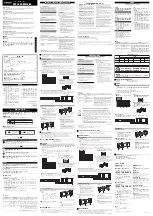
Rev 3.0.2 Mar.11
Proprietary and Confidential
19
test lab to determine how regulatory guidelines will impact the device compliance.
Proactive management of the regulatory process will minimize unexpected
schedule delays and costs due to unplanned testing activities.
Device classifications
The OEM integrator must determine the minimum distance required between their
device and the user’s body.
The FCC provides device classification definitions to assist in making the correct
determination. Note that these classifications are guidelines only; strict
adherence to a device classification may not satisfy the regulatory requirement as
near-body device design details may vary widely.
FCC definitions:
Portable: (§2.1093)—A portable device is defined as a transmitting device
designed to be used so that the radiating structure(s) of the device is/are
within 20 centimeters of the body of the user.
Mobile: (§2.1091)(b)—A mobile device is defined as a transmitting device
designed to be used in other than fixed locations and to generally be used in
such a way that a separation distance of at least 20 centimeters is normally
maintained between the transmitter’s radiating structure(s) and the body of
the user or nearby persons.
Per §2.1091d(d)(4) In some cases (for example, modular or desktop transmitters),
the potential conditions of use of a device may not allow easy classification of that
device as either Mobile or Portable. In these cases, applicants are responsible for
determining minimum distances for compliance for the intended use and
installation of the device based on evaluation of either specific absorption rate
(SAR), field strength, or power density, whichever is most appropriate.
OEM device classification process
The primary factor in determining whether a device will be classified as a Portable
product or as a Mobile product is antenna separation distance (body to radiating
antenna element).
The review process between the OEM module integrator and the preferred
regulatory test lab is a crucial step in determining the appropriate device
classification, as it is impractical for Sierra Wireless to define all possible
combinations of design features, antennas, physical configurations, and use-
models.
1.
Perform a device review with the preferred regulatory test lab to confirm
device classification.
2.
Determine the Certification type (Standalone or C2PC from an existing
Modular Grant).
3.
If the device classification is:
·
Portable: Preferred regulatory test lab to determine if a PBA or KDB is
required.
·
Mobile: Preferred regulatory test lab to determine if a PBA is required.
(Note: A PBA or KDB will likely be required for new technologies such as LTE
or WiMAX.)
Summary of Contents for AirPrime MC7750
Page 1: ...AirPrime MC7750 Hardware Integration Guide 2130114 Rev 3 0 2 ...
Page 2: ......
Page 12: ...AirPrime MC7750 Hardware Integration Guide 12 Proprietary and Confidential 2130114 ...
Page 22: ...AirPrime MC7750 Hardware Integration Guide 22 Proprietary and Confidential 2130114 ...
Page 27: ......
Page 28: ......










































